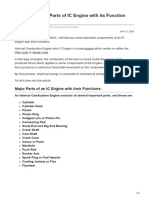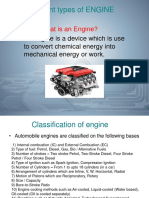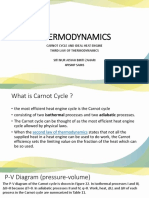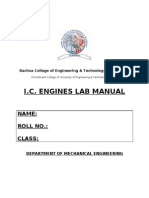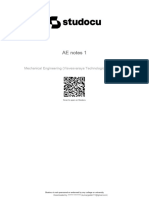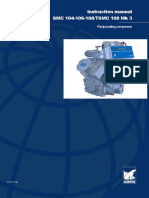4 Stroke Engine
4 Stroke Engine
Uploaded by
Ardi MaulanaCopyright:
Available Formats
4 Stroke Engine
4 Stroke Engine
Uploaded by
Ardi MaulanaCopyright
Available Formats
Share this document
Did you find this document useful?
Is this content inappropriate?
Copyright:
Available Formats
4 Stroke Engine
4 Stroke Engine
Uploaded by
Ardi MaulanaCopyright:
Available Formats
FOUR STROKE ENGINE
MAKALAH
Oleh Ahmad Khairul Faizin / 1131210060 Alif Masyuri / 1131210024 Ardi Maulana / 1131210123 Pebrian Dwi Sastyo / 1131210023 Ridar Lukmantya / 1131210166
JURUSAN TEKNIK MESIN POLITEKNIK NEGERI MALANG MALANG JANUARI 2013
1. PART OF FOUR STROKE ENGINE a. Piston A piston is a component of reciprocating engines, reciprocating pumps, gas compressors and pneumatic cylinders, among other similar mechanisms. It is the moving component that is contained by a cylinder and is made gas-tight by piston rings. In an engine, its purpose is to transfer force from expanding gas in the cylinder to the crankshaft via a piston rod and/or connecting rod. In a pump, the function is reversed and force is transferred from the crankshaft to the piston for the purpose of compressing or ejecting the fluid in the cylinder. In some engines, the piston also acts as a valve by covering and uncovering ports in the cylinder wall .
picture 1.1 Piston b. Connecting Rod In a reciprocating piston engine, the connecting rod or conrod connects the piston to the crank or crankshaft. Together with the crank, they form a simple mechanism that converts linear motion into rotating motion. Connecting rods may also convert rotating motion into linear motion. Historically, before the development of engines, they were first used in this way. As a connecting rod is rigid, it may transmit either a push or a pull and so the rod may rotate the crank through both halves of a revolution, i.e. piston pushing and piston pulling. Earlier mechanisms, such as chains, could only pull. In a few twostroke engines, the connecting rod is only required to push. Today, connecting rods are best known through their use in internal combustion piston engines, such as car engines. These are of a distinctly different design from earlier forms of connecting rods, used in steam engines and steam locomotives.
picture 1.2 Connecting Rod c. CrankShaft The crankshaft, sometimes abbreviated to crank, is the part of an engine that translates reciprocating linear piston motion into rotation. To convert the reciprocating motion into rotation, the crankshaft has "crank throws" or "crankpins", additional bearing surfaces whose axis is offset from that of the crank, to which the "big ends" of the connecting rods from each cylinder attach. It typically connects to a flywheel to reduce the pulsation characteristic of the four-stroke cycle, and sometimes a torsional or vibrational damper at the opposite end, to reduce the torsional vibrations often caused along the length of the crankshaft by the cylinders farthest from the output end acting on the torsional elasticity of the metal.
picture 1.3 CrankShaft d. Intake and Exhaust Valves There are two types of engine valves; intake and exhaust valves. The intake valves of course let air in, and the exhaust valves let exhaust air out. The more air you can move air in and out of the engine the more efficient, and therefor power the engine will have. This is why the engine valve plays a pretty critical role in an engines performance.
picture 1.4 intake adn exhaust valve e. Spark Plug A spark plug (sometimes in British English a sparking plug,[1] colloquially a plug) is a device for delivering electric current from an ignition system to the combustion chamber of a spark-ignition engine to ignite the compressed fuel/air mixture by an electric spark, while containing combustion pressure within the engine. A spark plug has a metal threaded shell, electrically isolated from a central electrode by a porcelain insulator. The central electrode, which may contain a resistor, is connected by a heavily insulated wire to the output terminal of an ignition coil or magneto. The spark plug's metal shell is screwed into the engine's cylinder head and thus electrically grounded. The central electrode protrudes through the porcelain insulator into the combustion chamber, forming one or more spark gaps between the inner end of the central electrode and usually one or more protuberances or structures attached to the inner end of the threaded shell and designated the "side", "earth", or "ground" electrode(s).
picture 1.5 Spark Plug 2. FOUR STROKE ENGINE CYCLE The four-stroke combustion cycle just like a gasoline engine. The four strokes are: Intake stroke -- The intake valve opens up, letting in air and moving the piston down. Compression stroke -- The piston moves back up and compresses the air. Combustion stroke -- As the piston reaches the top, fuel is injected at just the right moment and ignited, forcing the piston back down.
Exhaust stroke -- The piston moves back to the top, pushing out the exhaust created from the combustion out of the exhaust valve. 3. DIFFERENCE FOUR STROKE ENGINE ( gasoline engine) AND DIESEL ENGINE In theory, diesel engines and gasoline engines are quite similar. They are both internal combustion engines designed to convert the chemical energy available in fuel into mechanical energy. This mechanical energy moves pistons up and down inside cylinders. The pistons are connected to a crankshaft, and the up-and-down motion of the pistons, known as linear motion, creates the rotary motion needed to turn the wheels of a car forward. Both diesel engines and gasoline engines covert fuel into energy through a series of small explosions or combustions. The major difference between diesel and gasoline is the way these explosions happen. In a gasoline engine, fuel is mixed with air, compressed by pistons and ignited by sparks from spark plugs. In a diesel engine, however, the air is compressed first, and then the fuel is injected. Because air heats up when it's compressed, the fuel ignites.
picture 3.1 diesel engine model
Picture 3.2 four stroke engine model
4. STRENGTHS AND WEAKNESSES OF FOUR STOKE ENGINE Strengths : 1. More torque even at idling speed 2. No scavenging problems 3. No fresh mixture escaping with exhaust gases weaknesses : 1. Low power to weight ratio 2. More moving parts,not suitable for high speed 3. More number of stroke per circle 4. High service and overhaul cost due to more parts
You might also like
- Engine, Assembling: Service InformationDocument29 pagesEngine, Assembling: Service Informationducatiss90074% (23)
- VolvoTD70 Service Manual EngineDocument110 pagesVolvoTD70 Service Manual EngineHeikki Alakontiola87% (47)
- Repair Manual D2866LE enDocument156 pagesRepair Manual D2866LE enNazik94% (17)
- Iseki TH4295 4335 4365 Parts Manual 1Document350 pagesIseki TH4295 4335 4365 Parts Manual 1Вячеслав ШапочкаNo ratings yet
- Cylinder Head Gasket - Installation (08 - 2013 - ) (Cylinder Head Assembly) - Toyota Sienna 3.5ltsDocument8 pagesCylinder Head Gasket - Installation (08 - 2013 - ) (Cylinder Head Assembly) - Toyota Sienna 3.5ltsFran SanchezNo ratings yet
- Project Guide 5S60MC-CDocument313 pagesProject Guide 5S60MC-CHergheligiu Vasile67% (3)
- Guidebook - Updated 2019Document109 pagesGuidebook - Updated 2019DK White LionNo ratings yet
- SECTION 7001 Tractor BrakesDocument46 pagesSECTION 7001 Tractor Brakeslungu mihai100% (1)
- To Study The Stationary and Moving Automobile Parts PDFDocument16 pagesTo Study The Stationary and Moving Automobile Parts PDFTAHIR QAMAR100% (2)
- Petrol Engine DevigarhDocument7 pagesPetrol Engine Devigarhapi-3731257No ratings yet
- Four Stroke & Two StrokeDocument3 pagesFour Stroke & Two StrokeFarrukh Zia NagiNo ratings yet
- Four Stroke Petrol Engine: What Is An Engine?Document4 pagesFour Stroke Petrol Engine: What Is An Engine?UsamaNo ratings yet
- Jurnal Internasional PDFDocument9 pagesJurnal Internasional PDFTM RiskiNo ratings yet
- Structural IsomerismDocument4 pagesStructural IsomerismRenz Caballero EspinosaNo ratings yet
- Catalytic ConverterDocument11 pagesCatalytic ConverterAJ MukunNo ratings yet
- Lab Report 12Document8 pagesLab Report 12mamoona noreenNo ratings yet
- Fuel Cell Electric VehicleDocument18 pagesFuel Cell Electric VehicleRohit Patil100% (1)
- Chang - Lecture Slides of Chap11-Intermolecular ForcesDocument35 pagesChang - Lecture Slides of Chap11-Intermolecular ForcesJiselle GoconNo ratings yet
- Components or Parts of IC Engine With Its Function PDFDocument9 pagesComponents or Parts of IC Engine With Its Function PDFMilbert Vaz Alfonso100% (1)
- Lecture 2 - Internal CombussionDocument67 pagesLecture 2 - Internal Combussionchoongwenkang100% (2)
- Cooling System Report (Automotive Tech.)Document5 pagesCooling System Report (Automotive Tech.)Mohamed AhmedNo ratings yet
- Poka YokeDocument10 pagesPoka YokeDiana DianzzNo ratings yet
- MAS-9 Suspension System Tires and Wheels PDFDocument20 pagesMAS-9 Suspension System Tires and Wheels PDFSP CreationsNo ratings yet
- Three Domains of Learning - Cognitive, Affective, PsychomotorDocument9 pagesThree Domains of Learning - Cognitive, Affective, PsychomotorJulianne LegadaNo ratings yet
- 218 - Valve Timing and Ignition For CNGDocument5 pages218 - Valve Timing and Ignition For CNGAndres Fernando Sokol UrzagasteNo ratings yet
- Qip Ice 01 IntroductionDocument40 pagesQip Ice 01 IntroductionTiffany Powell100% (1)
- Makalah Units of MeasurementDocument10 pagesMakalah Units of MeasurementRaihan WibawaNo ratings yet
- Lancashire BoilerDocument12 pagesLancashire BoilerSNEH PODDARNo ratings yet
- 4.transfer BoxDocument21 pages4.transfer BoxThulasi RamNo ratings yet
- Lesson 2.1 Overview of I.C.E.Document8 pagesLesson 2.1 Overview of I.C.E.Andrew MerafuentesNo ratings yet
- Fuel Supply System Petrol EngineDocument7 pagesFuel Supply System Petrol EngineAmarChaudhary0% (1)
- Types of Power Plants - 2018 PDFDocument71 pagesTypes of Power Plants - 2018 PDFJeff Justine GeragaNo ratings yet
- Vinoharan PortfolioDocument162 pagesVinoharan PortfolioPradeep sanjeewaNo ratings yet
- Principles of CarburetionDocument39 pagesPrinciples of CarburetionmuthuNo ratings yet
- Different Types of ENGINEDocument31 pagesDifferent Types of ENGINEKarnal 0388100% (1)
- Accumulator PDFDocument7 pagesAccumulator PDFchildeyNo ratings yet
- 3-Way Catalytic ConverterDocument8 pages3-Way Catalytic Converterlalithkumaran LNo ratings yet
- Thermodynamics (Carnot Cycle and 3RD Law)Document15 pagesThermodynamics (Carnot Cycle and 3RD Law)Mirahmad FadzlyNo ratings yet
- Automobile Engines PDFDocument3 pagesAutomobile Engines PDFPrashant GautamNo ratings yet
- Tower LightDocument7 pagesTower LightsmttaaNo ratings yet
- Exhaust Gas Recirculation ReportDocument18 pagesExhaust Gas Recirculation Reportashoku2No ratings yet
- Automotive Brake System (Summary)Document6 pagesAutomotive Brake System (Summary)Rhenz MagnoNo ratings yet
- Gen. Bio 1 - Students - 2ND Qrt.Document80 pagesGen. Bio 1 - Students - 2ND Qrt.frve.felicano.swuNo ratings yet
- Chapter Three Performance Equations and Engine CharacteristicsDocument15 pagesChapter Three Performance Equations and Engine CharacteristicsbroNo ratings yet
- Engine Lubrication SystemDocument6 pagesEngine Lubrication SystemWaqar Younas NumberdarNo ratings yet
- How Do You Troubleshoot An Diesel Engine... PPT SaketDocument10 pagesHow Do You Troubleshoot An Diesel Engine... PPT SaketSaket Singh100% (1)
- Photosynthesis 1Document52 pagesPhotosynthesis 1Christian Benedict CruzNo ratings yet
- Diesel Engine - Combustion, Emissions and Condition Monitoring PDFDocument275 pagesDiesel Engine - Combustion, Emissions and Condition Monitoring PDFSamir Alshaar100% (1)
- Chemical Bonding and Atomic StructureDocument17 pagesChemical Bonding and Atomic StructureAliLakhoNo ratings yet
- Components of CarburetorDocument4 pagesComponents of Carburetorjunjun patagNo ratings yet
- The Second Law of Thermodynamics: MAE 320 - Chapter 6Document8 pagesThe Second Law of Thermodynamics: MAE 320 - Chapter 6Keilla Romabiles LeopandoNo ratings yet
- Automobile Ignition SystemDocument14 pagesAutomobile Ignition Systembalunkeswar ranaNo ratings yet
- Crystalline and Amorphous SolidsDocument16 pagesCrystalline and Amorphous SolidsDiana BelarminoNo ratings yet
- Engine Exhaust System Presentation by 14ME37Document14 pagesEngine Exhaust System Presentation by 14ME37Akash KumarNo ratings yet
- Collision TheoryDocument24 pagesCollision TheoryKHAIRUNNISALOQMANNo ratings yet
- Exponential & Logarithmic Functions Logarithmic Functions Logarithms Were Invented by John Napier Because of His Interest in Reducing ComplexDocument8 pagesExponential & Logarithmic Functions Logarithmic Functions Logarithms Were Invented by John Napier Because of His Interest in Reducing ComplexCaren Pelayo JonelasNo ratings yet
- ME 314, Internal Combustion Engine Sessional 1 2Document42 pagesME 314, Internal Combustion Engine Sessional 1 2Imam Arefin SwadhinNo ratings yet
- Pusa Institute of TechnologyDocument13 pagesPusa Institute of TechnologyAbhishek SinghNo ratings yet
- Theory of Engine OperationDocument19 pagesTheory of Engine OperationGabriel Dela Cruz LagmanNo ratings yet
- Chapter 1 Introduction: 1.1 Ic EngineDocument54 pagesChapter 1 Introduction: 1.1 Ic Engineavanish SinghNo ratings yet
- Unit 1Document32 pagesUnit 1Rakeshkumarceg100% (1)
- Exp No - Docx Gaurav Kr.Document13 pagesExp No - Docx Gaurav Kr.Prashant KashyapNo ratings yet
- Thermo Ex.1Document10 pagesThermo Ex.1Hafeez AliNo ratings yet
- English Task 6: Machine and Motors: Author: Nazhmi FadhilaDocument4 pagesEnglish Task 6: Machine and Motors: Author: Nazhmi FadhilaNazhmi FadhilaNo ratings yet
- Lab 1Document35 pagesLab 1Mamoon KhiljiNo ratings yet
- Diesel Engine: Carried Out byDocument22 pagesDiesel Engine: Carried Out byShivarajNo ratings yet
- Cata R8 Moteurs GB PDFDocument9 pagesCata R8 Moteurs GB PDFhothodNo ratings yet
- Operation and Maintenance Manual For Hand Pumps - : 2Nd EditionDocument21 pagesOperation and Maintenance Manual For Hand Pumps - : 2Nd EditionSandeep_AjmireNo ratings yet
- 6 Cylinder Head - ValveDocument14 pages6 Cylinder Head - ValveSaraNo ratings yet
- Value Engineering Case Study: TK StandsDocument9 pagesValue Engineering Case Study: TK StandsVivekanand DathivalasaNo ratings yet
- Ic Engines Laboratory ManualDocument35 pagesIc Engines Laboratory ManualYuvaraj Yuvi0% (1)
- Hyundai-B&w 1Document201 pagesHyundai-B&w 1shujauddin84100% (1)
- DMM 2Document8 pagesDMM 2Robin MessiNo ratings yet
- 1000 SERIES: 3 Stage Mast Parts ManualDocument46 pages1000 SERIES: 3 Stage Mast Parts ManualSifawSifaxBoudaoudNo ratings yet
- Pump SpecificationsDocument2 pagesPump Specificationsstranger252LavaNo ratings yet
- WM 601Document8 pagesWM 601Flávio GonçalvesNo ratings yet
- 1d Dvs B&W Man 48-98mc C Hyundai Vol 1 Operation 40e 442Document441 pages1d Dvs B&W Man 48-98mc C Hyundai Vol 1 Operation 40e 442tomo1973No ratings yet
- FX Series With QTV TechnologyDocument2 pagesFX Series With QTV TechnologyAlberto De la CruzNo ratings yet
- Ae Notes 1Document103 pagesAe Notes 1ಕುಮಾರ ಗುಬ್ಬಿNo ratings yet
- Rocking Steam Engines Vapeur MoteurDocument6 pagesRocking Steam Engines Vapeur MoteurSteve LebgNo ratings yet
- Engine Trouble in GeneralDocument5 pagesEngine Trouble in GeneralmiguelNo ratings yet
- Clippard Full-Line CatalogDocument364 pagesClippard Full-Line CatalogJohn Melanathy IINo ratings yet
- SMC 104 106 108 InstructionManual - 2004 05 - EngDocument194 pagesSMC 104 106 108 InstructionManual - 2004 05 - Engrodrigomalvon50% (2)
- Fire HydrantDocument6 pagesFire HydrantdileepsiddiNo ratings yet
- Steam Engine: GasolineDocument4 pagesSteam Engine: GasolineSahil SethiNo ratings yet
- 55D MT Triple Mast Parts List: 1900 North Street Marysville, Kansas 66508 (785) 562-5381Document66 pages55D MT Triple Mast Parts List: 1900 North Street Marysville, Kansas 66508 (785) 562-5381Christian BedoyaNo ratings yet
- Sellos y Bujes HYDROLINE PDFDocument29 pagesSellos y Bujes HYDROLINE PDFEfrain SaldañaNo ratings yet
- LAB Pneumatic FinalDocument25 pagesLAB Pneumatic FinalshamizNo ratings yet


















